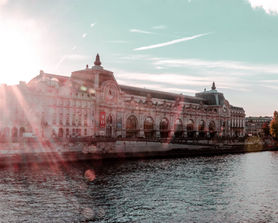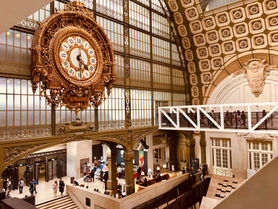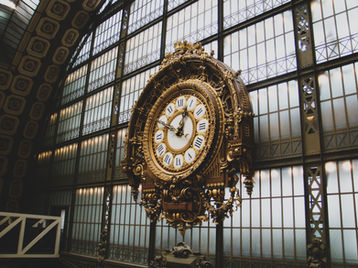
The Orsay museum
The architecture of the Musée d'Orsay is a unique blend of art nouveau and neoclassicism.
Formerly a train station designed by Victor Laloux, this historic building has been transformed into a modern museum to house masterpieces of impressionism, post-impressionism and neoclassicism.
His history...
The Musée d'Orsay is a memorable place located on the banks of the Seine in Paris. This magnificent building was inaugurated in 1986 and exhibits a collection ofpaintings, sculptures, art objects and photographs from the period 1848 to 1914. The history of the Musée d'Orsay is as fascinating as its works. We consider it one of the most beautiful museums in Paris, as much for its architecture which impresses us as for its absolutely incredible paintings!
The large semicircular arch windows, the vaulted ceilings and the monumental clocks are all proof of the delicacy of the Orsay station era. Visitors can also admire the bronze sculptures and wrought iron designs that adorn the stairs and balustrades.
The Musée d'Orsay has a remarkable collection of works by artists such as Monet, Degas, Cézanne,Van Gogh, Toulouse-Lautrec and many others. Impressionist paintings are particularly well represented, with canvases such as Monet's "Impression, Soleil Levant" and Degas' "Ballet de la Danseuse à la Barre." Visitors can also admire masterpieces of sculpture such as "La Danse" by Degas and "La Pensée" byRodin.
The Musée d'Orsay is also known for its unique and intimate atmosphere, which allows visitors to immerse themselves in the artistic universe of the period 1848 to 1914. There are many anecdotes, notably that of the transformation of the Orsay station in a museum. The old railway carriages have been transformed into exhibition spaces, giving visitors the impression of being immersed in the world of the Orsay station at the end of the 19th century.
Let's say it clearly, the Musée d'Orsay is an enchanting place for lovers of art and history. With its unique collection of works of art, its exceptional architecture and its intimate atmosphere, it is a place not to be missed for any visitor to Paris, as is theLouvre Museum where theQuai Branly Museumin a different style.
Current exhibitions
Impressionism at the Musée d'Orsay...
THEimpressionist movement, a central artistic movement of the second half of the 19th century in France, had a decisive influence on the history of art and marked an important stage in the evolution of modern painting.
The Impressionist style is characterized by an innovative technical approach to plein air painting, a bold use of light and color to suggest atmosphere and movement, and a preoccupation with everyday subjects and scenes of the modern life. Impressionist painters abandoned the academic conventions of traditional painting and focused on direct observation of reality.
The works of the Musée d'Orsay bear witness to the richness and variety of the Impressionist movement. Paintings by Monet, Degas, Renoir, Sisley and other artists show an innovative use of light and color to suggest the transparency and luminosity of air, as well as a concern with everyday subjects and scenes of modern life. Impressionist paintings are often composed of light, lively touches of color, which blend together to suggest atmospheres and movements.
A visit itinerary among others
If you only have two hours to visit the museum, we recommend starting withimpressionism on the 5th floor.
The Impressionist collection at the Musée d'Orsay is one of the largest in the world and features works by many important artists such as Monet, Renoir, Degas, Cézanne and many others. The Impressionists are known for their use of light, color and nature as recurring themes.
Going down to the 4th floor you will find the post-impressionist collection. This section of the museum highlights the works of artists such as Van Gogh, Gauguin and Seurat. The Post-Impressionists continued the Impressionists' exploration of light and color, but also incorporated more symbolic and abstract elements into their art.
On the 3rd floor, you can discover the collection of sculptures. This section of the museum highlights works by famous French sculptors such as Auguste Rodin and Camille Claudel. The sculptures featured in this section were created at a time when sculpture was considered a major art form and artists worked with a variety of materials to create stunning pieces.
Finally, the decorative arts collection on the 2nd floor presents decorative art objects and furniture from the 19th century. You can discover a variety of decorative art objects such as clocks, vases and tapestries, as well as furniture designed by renowned artists such as Louis Majorelle and Gustave Serrurier-Bovy
Some works in light



Vincent van Gogh's "Starry Night over the Rhône", an oil painting from 1888, measuring 72.5 x 92 cm, even if we seem to know it by heart, is certainly our favorite painting in Orsay. This work is one of van Gogh's many depictions of the starry night, which became a recurring theme in his work. In this painting, van Gogh used swirling brushstrokes and bright colors to create an intense nighttime landscape, with a palette dominated by deep blues and brilliant yellows. The Rhône is represented with vibrant reflections, which create a calm and mysterious atmosphere. This work is an excellent example of van Gogh's technique, which influenced many Impressionist and Post-Impressionist artists.




“Lunch on the Grass” by Édouard Manet is an oil painting from 1863, measuring 208.5 x 264.5 cm. This painting was first exhibited at the Salon des Refusés of 1863 and caused great controversy due to its bold depiction of two clothed men and two nude women in a wooded landscape. Women are depicted without any idealism or romanticism, which shocked contemporary critics. Manet used a soft color palette and realistic technique to create this work, which is considered one of the most influential works in the history of modern art. She was a catalyst for the Impressionist movement that would follow.




We cannot miss this furiously famous work, "The Origin of the World" by the French artist Gustave Courbet, produced in 1866. This oil painting on canvas represents a close-up of the torso and genitals of a woman lying on a bed, with extreme precision and striking realism.
The work was considered scandalous when it was created and caused considerable controversy. You can easily imagine why...
However, taking a closer look at Courbet's work, one can appreciate the artistic quality of this work. The composition is balanced and the painting is of high technical quality. The colors and texture of the skin are beautifully rendered, creating a sense of sensuality and raw sensuality.
The work is also interesting from a historical and cultural perspective, as it reflects the artistic and social concerns of the time. Courbet was known for his commitment to realism, an artistic approach that emphasized the accurate and honest depiction of reality. “The Origin of the World” is therefore a manifestation of this approach, which was used to explore taboo subjects and challenge the artistic and social norms in force at the time.

Image gallery









